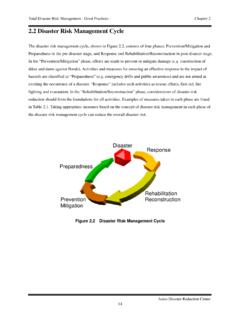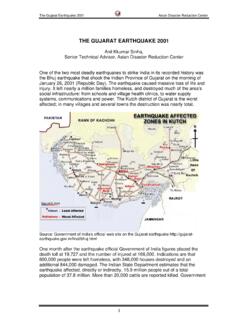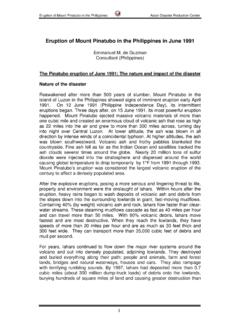Transcription of RESEARCH REPORT STUDY ON EARTHQUAKE RISK AND …
1 RESEARCH REPORT . STUDY ON EARTHQUAKE RISK AND VULNERABILITY MANAGEMENT. and LESSONS LEARNED. ANNA-LISA DUMAGUING ORALLO. Office of Civil Defense PHILIPPINES. ARDC VISITING RESEARCHER 2011A. July October 2011. Disclaimer This REPORT was compiled by an ADRC visiting researcher (VR) from ADRC. member countries. The views expressed in the REPORT do not necessarily reflect the views of the ADRC. The boundaries and names shown and the designations used on the maps in the REPORT also do not imply official endorsement or acceptance by the ADRC. Table of Content I. Foreword II. Objective III. Introduction A. Republic of the Philippines B. Japan IV. The Philippine Disaster Management System A. Natural Hazards Likely to Affect the Country B. Recent Major Disasters in the Philippines C. The Legal Authority 1. The National Disaster Coordinating Council (NDCC).
2 2. The Office of Civil Defense (OCD). 3. The NDCC Comprehensive Disaster Risk Management Framework 4. National Disaster Risk reduction and Management Council (NDRRMC). 5. Republic Act 10121. 6. The NDRRMC Framework 7. Salient Features 8. NDRRMC Aspects 9. The Council Members 10. Authority of the Chairperson 11. Duties and Responsibilities of the Council Members V. The Disaster Management of Japan A. The Natural Hazards in Japan B. The Recent Disasters in Japan C. The Disaster Management 1. Progress in Disaster Management Law and Systems 2. Mission of the Cabinet Office 3. The Central Management Council 4. Duties of the Central Management Council 5. Disaster Management Planning a. Disaster Management Planning System b. Basic Disaster Management Plan 6. Disaster Management Budget 7. Disaster Response Mechanism VI. RESEARCH STUDY on EARTHQUAKE A.
3 Pacific Ring of Fire B. Hazards Posed by EARTHQUAKE 1. Ground Shaking 2. Ground Rupture 3. Tsunami 4. Liquefaction 5. Landslide 6. Fire 7. Flood 8. Human Impact VII. EARTHQUAKE Around the Earth A. Japan 1. STUDY on the Tonankai and Nankai EARTHQUAKE a. National Land Conservation b. Observing, Forecasting and Warning Disaster risks c. Information and Communication System d. Integrated Disaster Management Information System e. Development of Disaster Management Bases f. Issuing of Evacuation Order and Instruction g. Measures for People Requiring Assistance During Disaster h. Disaster reduction Drills and Exercises 2. EARTHQUAKE Disaster Countermeasures a. Observation System 1. Japan Meteorological Agency (JMA). 2. Japan Agency Marine Science and Technology (JAMSTEC). b. EARTHQUAKE Proofing of Houses and Buildings c. Coastline Projects 3.
4 Tsunami Countermeasures a. Disaster Awareness Enhancement and Disaster Knowledge Dissemination b. Improvement of Environment for Disaster Management Volunteers Activities B. Philippines 1. STUDY of Metro Manila EARTHQUAKE a. Fault in the Philippines b. EARTHQUAKE Generators 2. The Philippine Response Towards Disaster reduction 3. The Metro Manila Impact EARTHQUAKE reduction STUDY (MMIERS). a. Possible Regional Separation b. The Goal 1. Develop National System Resistant to EARTHQUAKE Impact 2. Improve Metropolitan Manila's Urban Structure Resistant to EARTHQUAKE 3. Enhance Effective Management System 4. Enhance Community Disaster Management Capacity 5. Formulate Construction System 6. Promote RESEARCH Technology Development on EARTHQUAKE c. High Priority Action Plan 4. EARTHQUAKE Disaster Countermeasures a. Integration of Disaster Risk Management in Development Program b.
5 READY Project c. REDAS. d. Installation of EARTHQUAKE Intensity Meters e. The Manila Map Viewer f. The Metro Manila Development Authority Initiatives g. PEER. h. The Department of Education (DepEd) and Commission on Higher Education (CHED) Initiatives 5. Tsunami Countermeasures a. PHIVOLCS Program 1. Tidetool 2. Hazard Maps b. SWEEP School Project 6. NDRRMC Partnership with Private Sectors VIII. Disaster preparedness of Metro Manila Municipalities and Cities IX. Conclusion X. References Foreword Objective of the RESEARCH : Enhance legal framework and institutional capacity for disaster risk reduction and management Strengthen community capacity and knowledge on disaster risk reduction and management III. General Information: A. Republic of the Philippines The Republic of the Philippines (RP) is an archipelagic nation located in Southeast Asia.
6 Three prominent bodies of water surround the archipelago: the Pacific Ocean on the east, the South China Sea on the west and north, and the Celebes Sea and the coastal waters of Borneo on the south. The Philippines constitutes an archipelago of 7,107. islands and has a total land area of approximately 300,000. square kilometers. Large mountainous terrain, narrow coastal plains and interior valleys and plains make up the country's topography. The country's capital is Manila. The population estimated is million as of July 2009 with a growth rate of Ninety percent (90%) of the Filipino population is Christians. Eighty-three percent (83%) is predominantly Roman Catholics. It has a democratic form of government. The country is divided into three major island groups. Luzon is the largest island group with an area of 141,000 square kilometers, followed by Mindanao covering 102,000 square kilometers, and the Visayas with 57,000 square kilometers.
7 The rest are small islets that emerge and disappear with ebbing and rising of tides. The Philippines has a tropical and maritime climate. Using temperature and rainfall as bases, its climate can be divided into two major seasons: (1) the rainy season, from June to November; and (2) the dry season, from December to May. The dry season may be subdivided further into (a) the cool dry season, from December to February; and (b) the hot dry season, from March to May. The Philippines is a newly industrialized country, with an economy anchored on agriculture but with substantial contributions from manufacturing, mining, remittances from overseas Filipinos, and service industries such as tourism, and business process outsourcing. B. JAPAN. Japan is an island nation in East Asia. Located in the Pacific Ocean, it lies to the east of the Sea of Japan, People's Republic of China, North Korea, South Korea and Russia, stretching from the Sea of Okhotsk in the north to the East China Sea and Taiwan in the south.
8 The characters that make up Japan's name mean "sun-origin", which is why Japan is sometimes referred to as the "Land of the Rising Sun". A major economic power, Japan has the world's third-largest economy by nominal GDP and by purchasing power parity. It is also the world's fourth largest exporter and fourth largest importer. After Singapore, Japan has the lowest homicide (including attempted homicide) rate in the world. According to both UN and WHO. estimates, Japan has the longest life expectancy of any country in the world. According to the UN, it has the third lowest infant mortality rate. Japan consists of forty-seven prefectures, each overseen by an elected governor, legislature and administrative bureaucracy. Each prefecture is further divided into cities, towns and villages. Japan has a total of 6,852 islands extending along the Pacific coast of Asia.
9 The main islands, from north to south, are Hokkaid , Honsh , Shikoku and Ky sh . The Ry ky Islands, including Okinawa, are a chain to the south of Ky sh . Together they are often known as the Japanese Archipelago. About 73 percent of Japan is forested, mountainous, and unsuitable for agricultural, industrial, or residential use. As a result, the habitable zones, mainly located in coastal areas, have extremely high population densities. Japan is one of the most densely populated countries in the world. The islands of Japan are located in a volcanic zone on the Pacific Ring of Fire. They are primarily the result of large oceanic movements occurring over hundreds of millions of years from the mid-Silurian to the Pleistocene as a result of the subduction of the Philippine Sea Plate beneath the continental Amurian Plate and Okinawa Plate to the south, and subduction of the Pacific Plate under the Okhotsk Plate to the north.
10 Japan was originally attached to the eastern coast of the Eurasian continent. The subducting plates pulled Japan eastward, opening the Sea of Japan around 15 million years ago. Japan has 108 active volcanoes. Destructive earthquakes, often resulting in tsunami, occur several times each century. The 1923 Tokyo EARTHQUAKE killed over 140,000 people. More recent major quakes are the 1995 Great Hanshin EARTHQUAKE and the 2011 T hoku EARTHQUAKE , a quake which hit Japan on March 11, 2011, and triggered a large tsunami. A major feature of Japan's climate is the clear-cut temperature changes between the four seasons. In spite of its rather small area, the climate differs in regions from a subarctic climate to a subtropical climate. The side of the country which faces the Sea of Japan has a climate with much snow in winter by seasonal winds from the Siberia.




